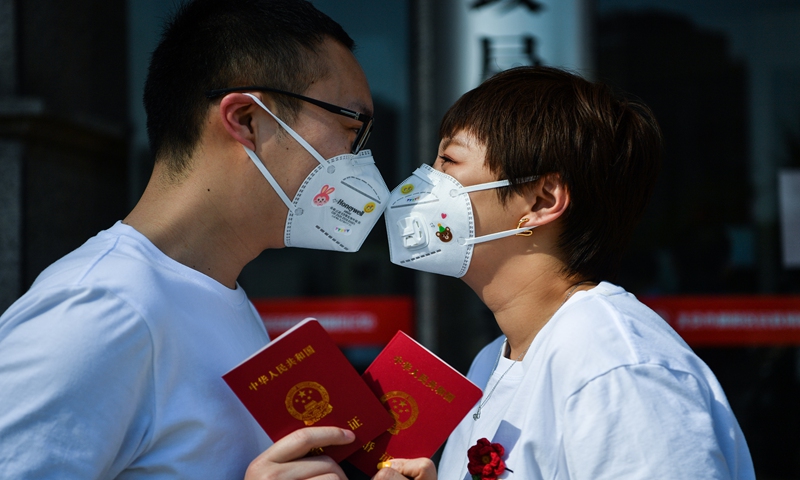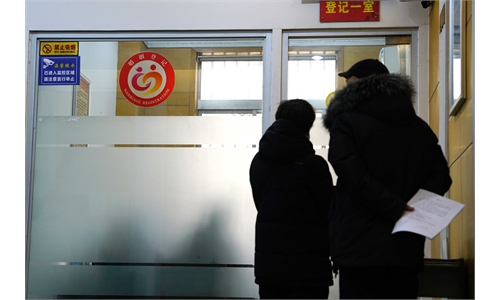Beijing launches level 2 emergency response amid COVID-19 rebound as thousands register marriage on Chinese Valentine's Day

A couple kiss each other and show their marriage certificate on May 20, 2020 which is considered China's second unofficial Valentine's Day after Western Valentines. Photo: VCG
May 20, Chinese Valentine's Day, is seeing a peak of marriage registrations, with 5,521 couples in Beijing applying for registration, prompting Beijing to launch a second level emergency response amid a rebound of sporadic COVID-19 cases in China. The date was chosen for Chinese Valentine's day, as "5.20" sounds similar to "I love you" in Chinese.
In order to prevent cluster infections, couples have to apply for registration online, and those without appointments cannot be registered on Thursday. Registration is being conducted in staggered times, and couples with appointments are requested to wait in line to be called for registration.
With a resurgence of COVID-19 cases in East China's Anhui Province and Northeast China's Liaoning Province recently raising public alarm, all district civil affairs bureaus in Beijing have set up work teams to coordinate public security, urban management, health and sub-district departments to strengthen the organization and maintenance of order of marriage registration sites, formulating emergency response plans on the day and strengthening emergency drills.
Gatherings and crowds are not allowed, couples are requested to show their green health code when entering registration sites, and indoor facilities and equipment have been disinfected. Staff members of civil affairs bureaus are requested to wash their hands and disinfect before and after handling marriage registration business, and wear masks.
Many civil affairs bureaus saw long queues of couples looking to register their marriage, China Youth Daily reported on Thursday. The report said some couples had waited in line from very early in the morning in areas such as Zhengzhou, Central China's Henan Province, Xiangtan, Central China's Hunan Province, and Zaozhuang, East China's Shandong Province.
China's Ministry of Civil Affairs announced on Wednesday that it would launch a pilot program allowing couples to get married or divorced across provinces and municipalities in Liaoning, Shandong, South China's Guangdong, Southwest China's Sichuan and Chongqing, starting from June 1, 2021 to May 31, 2023.
According to the new policy, both men and women in these pilot areas will also be able to register their marriages or divorces at the habitual residence of one of the couples.
With the rapid development of the economy and society, many people who go out to work, live or study for a long time, have found it inconvenient to go back to their hometown to register their marriage, creating a strong demand for "inter-provincial" marriage registration, according to the ministry.
After one civil affairs bureau announced it would not accept divorce registration on "5.20", triggering controversy online, the ministry said that marriage and divorce registrations are both statutory duties of bureaus. The bureau in question has apologized and corrected its wrong doing.
Also, following the recent COVID-19 cases, the epidemic-hit area in Yingkou, Liaoning Province suspended marriage registrations on Thursday as part of epidemic prevention and control measures, according to the ministry.
The ministry said that every year, about 10 million couples register their marriages, and nearly 4 million register for divorces.
Since the cooling-off period policy was introduced for divorce registrations at the beginning of this year, the number of registered divorces in China plunged in the first quarter after continuously rising for years, to only 296,000 cases, 70 percent lower than in the last quarter of 2020 and first quarter of 2019, official data showed.
Global Times


